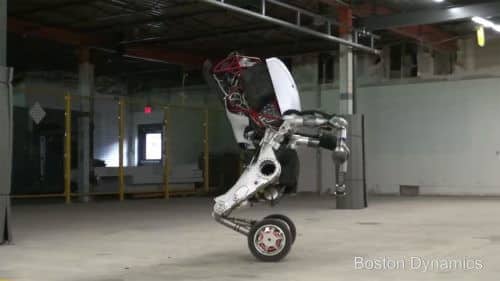A few months ago I had the privilege of attending a lecture by one of the senior engineers at Boston Dynamics. The company, for those who don't know, builds robots. But not just any robots: her machines walk on four or two legs, thus imitating the way animals and humans move. One of the company's most famous robots is Big Dog (big dog, in Polish), which was originally intended to be used by the United States Army to carry loads on the battlefield. Another famous robot is Atlas, which moves on two legs as if it were human, and is also able to open doors, carry boxes, and even do push-ups.

At the end of the lecture, I raised my hand and asked why the company's engineers are actually concentrating only on robots that imitate one-to-one the biological movement pattern. "Why do you rely only on mechanisms developed during evolution to support biological creatures that also need to bend down to gather food, carry their offspring and mate? Why don't you try to find more efficient ways to move, which evolution never found?"
It turns out they listened to me there.
(Full disclosure: most likely they didn't listen, and the new robot is the product of research work that began long before I raised my hand. But I'm allowed to daydream, aren't I?)
The new robot demonstrated by Boston Dynamics in recent days is able to move on two wheels, and balance the center of gravity of its body perfectly. It demonstrates a fast and impressive ability to move - certainly faster than Atlas and Big Dog - although it will certainly be limited mainly to paved surfaces such as roads and sidewalks. And what if he runs into the step? There is nothing to worry about - he is able to jump like a horse over obstacles a meter or more high.
The founder of Boston Dynamics defined the machine as a "nightmare-inducing robot", and it is not difficult to understand why. The company's previous robots resembled in their form and movement the biological creatures we are used to seeing everywhere - dogs and humans. The new robot is new in the full sense of the word: it is a hybrid creature that has never existed before in the entire history of the earth. It combines in one body the wheel - a technology that is not useful in an environment that does not contain roads or smooth surfaces - and the biological legs and the ability to maintain perfect balance.
The new robot shows us what the robots of the future could look like: very different from Asimov's visions of human-looking robots, and perfectly adapted to the purposes for which they were created. Similar robots will be able to roam the roads and sidewalks in ten years or less, carry loads and deliveries, and maybe even take people to their desired district. And yes - they can also be terrifying war machines, which will function in urban areas. These machines will be resistant to bullets thanks to appropriate shielding and the ability to balance and avoid falling following the impact. Their speed of movement will allow them to carry old-new weapons: blades that can cause terrible damage to civilians in crowded environments.
Such a warlike robot can truly give rise to nightmares, as the founder of Boston Dynamics stated. But until the next great war comes, it is possible and appropriate to be impressed by the decision to abandon the outdated biological movement patterns in favor of more innovative and useful bodies and patterns. The company produced the technology - and now it's our job to watch over it, and make sure it's used for needs that will benefit humans.

5 תגובות
The robot does not inspire nightmares
Will the robots overtake us in the near future?
In the current trend, we are descending to the level of robots, so it is clear that perfect human imitations will soon "appear".
Asimov is not wrong
In the future we will see robots that are perfect imitations of humans
The complex form and the diverse way of functioning of nature's creatures are deeply embedded in our minds, and they are like no obstacle on the way to planning, and building an artificial robotic "something", which is supposed to carry out specific goals. Another obstacle facing the planners/developers is the recognition or knowledge of solutions, which makes it very difficult (based on research) to find different new solutions that are often more effective and correct.
Sometimes I think it is necessary to limit the development of science and technology in the offensive military field, there are things that can be developed, but maybe you should think again and maybe not continue developing them.
The situation today is that the sophisticated weapons that are invented in technologically developed countries end up with crazy dictators and terrorists who would not have come up with it on their own.
The countries of the western world have too many technological weapons and military power, they no longer fight each other, and do not need all this arsenal.